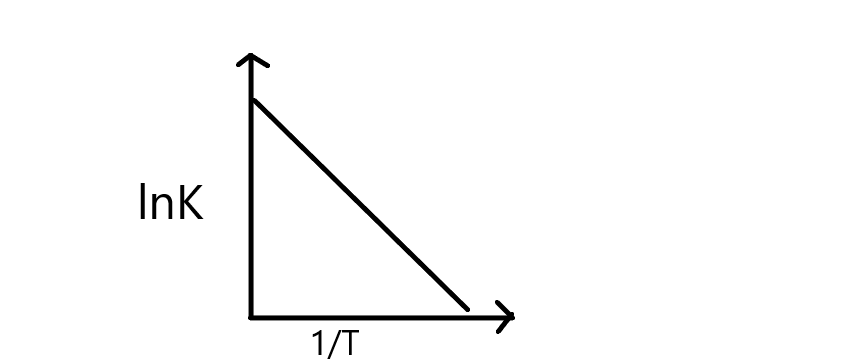
Answer
442.8k+ views
Hint: Arrhenius equation is useful for calculating the energy of activation of a reaction having rate constant “k” at temperature “T”
Activation energy is the excess energy that the reacting molecules whose energy is less than threshold energy must acquire to react to give the products.
Activation energy can be obtained graphically by the slope of lnK vs \[\dfrac{1}{T}\]
Complete step by step answer:
Arrhenius equation for calculating the energy of activation of a reaction having rate constant “k” at temperature “T” can be written as follows,
\[k = A{e^{\dfrac{{ - {E_a}}}{{RT}}}}......(1)\]
Where,
k- Rate constant
A- Frequency factor
${E_a}$- Arrhenius activation energy
R-Gas constant
T-Temperature
Taking the natural logarithm of equation (1) on both sides,
\[(1) \Rightarrow \ln k = \ln A + \left( {\dfrac{{ - {E_a}}}{{RT}}} \right)\]
\[ \Rightarrow \ln k = \left( {\dfrac{{ - {E_a}}}{{RT}}} \right) + \ln A.......(2)\]
Equation (2) depicts the \[y = mx + c\] equation where
\[y = ln{{ }}k\]
\[m = \dfrac{{ - {E_a}}}{R}\]
\[x = \dfrac{1}{T}\]
\[c = ln{{ }}A\]
Thus, the plot $lnK\;{{ }}\;vs{{ }}\;\dfrac{1}{T}$ can be drawn as,

From the graph, it depicts that rate constant decreases with increase in $\dfrac{1}{T}$ resulting in a straight line, and its slope can be equal to \[\dfrac{{ - {E_a}}}{R}\]
Thus, from the slope \[\ln Kvs\dfrac{1}{T}\], we can calculate the activation energy of a reaction.
Note: The slope of the natural logarithm of the Arrhenius equation is negative. \[m = \dfrac{{ - {E_a}}}{R}\] Where \[R = 8.314J{K^{ - 1}}mo{l^{ - 1}}\]
The rate constant is affected by temperature whereas activation energy is independent of temperature. The activation energy is affected by the use of catalysts. . Generally, activation energy is the excess energy required by the molecules to react to yield a product. When a catalyst is used, the activation energy barrier gets decreased and it makes the reaction happen faster.
When the temperature increases, more molecules are undergoing collision and temperature cannot change the activation barrier of a reaction.
Activation energy is the excess energy that the reacting molecules whose energy is less than threshold energy must acquire to react to give the products.
Activation energy can be obtained graphically by the slope of lnK vs \[\dfrac{1}{T}\]
Complete step by step answer:
Arrhenius equation for calculating the energy of activation of a reaction having rate constant “k” at temperature “T” can be written as follows,
\[k = A{e^{\dfrac{{ - {E_a}}}{{RT}}}}......(1)\]
Where,
k- Rate constant
A- Frequency factor
${E_a}$- Arrhenius activation energy
R-Gas constant
T-Temperature
Taking the natural logarithm of equation (1) on both sides,
\[(1) \Rightarrow \ln k = \ln A + \left( {\dfrac{{ - {E_a}}}{{RT}}} \right)\]
\[ \Rightarrow \ln k = \left( {\dfrac{{ - {E_a}}}{{RT}}} \right) + \ln A.......(2)\]
Equation (2) depicts the \[y = mx + c\] equation where
\[y = ln{{ }}k\]
\[m = \dfrac{{ - {E_a}}}{R}\]
\[x = \dfrac{1}{T}\]
\[c = ln{{ }}A\]
Thus, the plot $lnK\;{{ }}\;vs{{ }}\;\dfrac{1}{T}$ can be drawn as,

From the graph, it depicts that rate constant decreases with increase in $\dfrac{1}{T}$ resulting in a straight line, and its slope can be equal to \[\dfrac{{ - {E_a}}}{R}\]
Thus, from the slope \[\ln Kvs\dfrac{1}{T}\], we can calculate the activation energy of a reaction.
Note: The slope of the natural logarithm of the Arrhenius equation is negative. \[m = \dfrac{{ - {E_a}}}{R}\] Where \[R = 8.314J{K^{ - 1}}mo{l^{ - 1}}\]
The rate constant is affected by temperature whereas activation energy is independent of temperature. The activation energy is affected by the use of catalysts. . Generally, activation energy is the excess energy required by the molecules to react to yield a product. When a catalyst is used, the activation energy barrier gets decreased and it makes the reaction happen faster.
When the temperature increases, more molecules are undergoing collision and temperature cannot change the activation barrier of a reaction.
Recently Updated Pages
Fill in the blanks with suitable prepositions Break class 10 english CBSE

Fill in the blanks with suitable articles Tribune is class 10 english CBSE

Rearrange the following words and phrases to form a class 10 english CBSE

Select the opposite of the given word Permit aGive class 10 english CBSE

Fill in the blank with the most appropriate option class 10 english CBSE

Some places have oneline notices Which option is a class 10 english CBSE

Trending doubts
Fill the blanks with the suitable prepositions 1 The class 9 english CBSE

How do you graph the function fx 4x class 9 maths CBSE

When was Karauli Praja Mandal established 11934 21936 class 10 social science CBSE

Which are the Top 10 Largest Countries of the World?

What is the definite integral of zero a constant b class 12 maths CBSE

Why is steel more elastic than rubber class 11 physics CBSE

Distinguish between the following Ferrous and nonferrous class 9 social science CBSE

The Equation xxx + 2 is Satisfied when x is Equal to Class 10 Maths

Differentiate between homogeneous and heterogeneous class 12 chemistry CBSE




